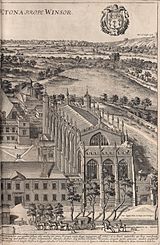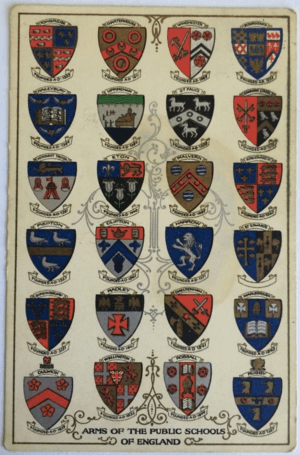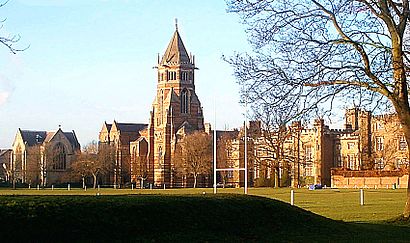Public school (United Kingdom) facts for kids
A public school in England and Wales is a special kind of school. These schools charge fees for students to attend. They were originally for older boys. They were called "public" because they were open to students from anywhere. It didn't matter where they lived, what their family's religion was, or what their parents did for work.
The term "public school" has been used for a long time, since at least the 1700s. Its meaning became official with the Public Schools Act 1868. This law followed a report called the Clarendon Report from 1864. This report looked into nine famous schools. Seven of these schools were changed by the new law. These included Eton, Shrewsbury, Harrow, Winchester, Rugby, Westminster, and Charterhouse.
Public schools have always had a strong connection to the leading families in the UK. In the past, the sons of important officials in the British Empire often went to these schools. This happened while their fathers were working in other countries. In 2019, many government ministers in the United Kingdom had gone to these fee-charging schools.
Contents
What is a Public School?
The Independent Schools Information Service helps promote independent schools in Britain. They say that "public school" usually means about 215 independent schools. Most of these are for boys and belong to the Headmasters' Conference. The name came from a time when schools started for local children. They then became "public" by letting in children from further away. The term also describes about 230 senior schools for girls. These schools belong to the Girls' Schools Association.
History of Public Schools

How Public Schools Began
Before the late Middle Ages, most schools were run by the church. They often had strict rules about who could join. Other schools were only for the sons of people in certain jobs or groups. As society changed, there was a need for schools for the sons of wealthy families. These schools needed to be separate from church control. They also needed to be open to everyone.
From the 1500s onwards, schools for boys who lived at the school (boarding schools) were started. Many of these schools were only for boys. They were also full boarding schools, meaning students lived there all the time.
Separate schools for younger boys, called "prep schools," started in the 1830s. After this, older boys usually entered the main public schools at age 12 or 13. The first prep school was Windlesham House School. It was supported by Thomas Arnold, who was the headmaster of Rugby School.
Many public schools, like Rugby School and Harrow School, faced problems in the 1700s. Some almost closed in the early 1800s. For example, protests in a local newspaper helped keep the Perse School open. A court case in 1837 also led to changes in how the school's money was managed.
Changes in Victorian Times

* Tonbridge * Charterhouse * Winchester * Bedford * Haileybury * Uppingham * St Paul's * Manchester Grammar * Merchant Taylors' * Eton * Malvern * King Edward VI * Repton * Clifton * Harrow * St Edwards * Shrewsbury * Radley * Cheltenham * Marlborough * Dulwich * Wellington * Rossall * Rugby
A special committee, the Clarendon Commission, looked into nine well-known schools from 1861 to 1864. Seven of these were boarding schools. These included Charterhouse, Eton, Harrow, Rugby, Shrewsbury, Westminster, and Winchester. Two were day schools: St Paul's and the Merchant Taylors'.
The Public Schools Act 1868 brought rules and changes to these "public schools." This law gave the first official definition of a public school. It said they were schools open to anyone who could pay, from anywhere in the country. This was different from a local school only for people nearby. It was also different from a religious school only for members of a certain church. St Paul's School and Merchant Taylors' School argued that they were "private" schools. So, they were not included in this law.
In 1887, courts decided that the City of London School was also a public school.
After the Clarendon Commission, another group, the Taunton Commission, looked at 782 other grammar schools. They suggested ways to change how these schools used their money. These ideas were put into the Endowed Schools Act 1869. In that same year, the headmaster of Uppingham School invited other headmasters to meet. He wanted to discuss the new law. This meeting led to the creation of the Headmasters' Conference (HMC). This group has grown to include over 200 schools.
The Public Schools Yearbook was first published in 1889. It listed 30 schools, mostly boarding schools. Later editions added more successful grammar schools. By 1902, it included all schools whose headmasters were part of the Headmasters' Conference.
Public Schools in the 20th Century
The Fleming Report in 1944 defined a public school as a member of certain school groups. Based on this report, the Education Act 1944 gave a new status to grammar schools that received money from the government. These "direct grant grammar schools" got some state funding. In return, they had to take 25% to 50% of their students from state primary schools. Many HMC schools became direct grant schools. This meant nearly half of their student places were paid for by the state.
The Fleming Committee also suggested that a quarter of public school places should be for a national scholarship program. This was for children who would benefit from boarding. However, this program did not grow much. This was because money was tight, and there wasn't enough support from schools or local authorities.
Modern Public Schools
The 1960s brought big social changes. Students protested about many things. These events also affected British public schools. Headmasters noticed that students were questioning old ways of doing things. These challenges happened at the same time as an economic downturn in the mid-1970s. The government also wanted to make a clearer difference between independent and state schools.
Many boarding schools began to accept students who only attended during the day. Some schools stopped offering boarding completely. Others started accepting girls in the sixth form (the last two years of high school). Some even became fully co-educational, meaning they accepted both boys and girls.
Old traditions like "fagging" were stopped in the 1970s and 1980s. Fagging meant younger students had to act as personal helpers for older students. Corporal punishment, which was physical punishment, was banned in state schools in 1986. Most public schools had already stopped using it by then. It was formally banned in independent schools in 1999 in England and Wales.
When government grants were stopped in 1975, many HMC schools became fully independent. Local authorities were also told to stop paying for places at independent schools. This caused financial problems for many schools. To survive, many became co-educational. Between 1981 and 1997, a program called the Assisted Places Scheme helped some students. It provided money for 80,000 students to attend private schools.
Today, more than half of HMC schools teach both boys and girls. Of the original nine Clarendon schools, two accept girls only in the sixth form. Two are fully co-educational (Rugby and Shrewsbury). Five still only accept boys and are full boarding schools. These are Eton College, Sherborne School, Radley College, Winchester College, and Harrow School. The newest public school to join the HMC is Yarm School, which started in 1978.
Most public schools are connected to a Christian religion. Many are linked to the Church of England. Some are linked to the Roman Catholic or Methodist churches. A few schools are not religious at all, like Oswestry School.
Public Schools and Leaders

Before World War II, public schools helped prepare students to be leaders. This type of education, with its focus on old languages and social manners, became a sign of the ruling class. For 300 years, the sons of British Empire officers often went back to boarding schools in England for their education. They sometimes stayed for a year or more at a time.
The public school spirit in the 1800s promoted ideas of serving the country and the Empire. Famous sayings like "it's not whether you win or lose, it's how you play the game" came from this time. Many former students loved their old schools. Having gone to a public school and knowing other former students could be helpful in a career.
After the war, society changed. Britain's education system also changed. Some parents, who could afford the fees or got scholarships, chose public schools. In 2009, typical fees for boarding students were around £30,000 per year.
In 2015, Prime Minister David Cameron (who went to Eton) and Chancellor of the Exchequer George Osborne (who went to St Paul's) both attended Clarendon schools. While some Prime Ministers went to public schools, others went to state schools. For example, between 1964 and 1997, all six British Prime Ministers went to state schools. Prime Minister Theresa May also mainly went to state schools.
Even though wealthy families don't control independent schools as much now, these schools still have influence. They educate less than 10% of the population. But studies show that many people in important jobs went to independent schools. A 2012 study found that 44% of leading people in politics, business, and the arts went to independent schools. It also found that 10 elite fee-paying schools produced 12% of these top leaders. A 2014 study found that many senior judges, army officers, and government officials were privately educated.
Images for kids
See also
 In Spanish: Public school para niños
In Spanish: Public school para niños



